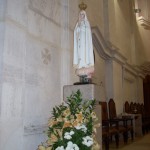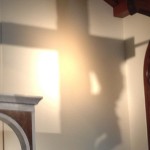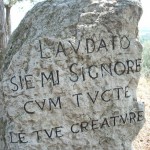“It’s a good Friday, for lots of reasons!” Ann Curry chirped on the TODAY Show this morning.
The reasons? An exclusive interview with the British woman who’s getting international guff for complaining about how tough life is when you’re beautiful. Another exclusive with Kim Kardashian, who also chirps as she explains how cuddling with Kanye West at The Hunger Games helps her mourn the ending of her 72-day marriage. A visit from the host of a TV fishing show. (Well, at least that’s fish.) The news that President Obama, a faithful worshiper at the Church of Political Expediency, is hosting a Seder at the White House tonight. (Nothing against Seders at the White House, and delighted to wish Jews around the world a blessed Pesach, but come on. I sincerely hope Elijah walks through the door and gives the president the 411 about what religious freedom and deliverance from government tyranny really mean.) And an in-studio concert from Nicki Minaj, the singer who makes a career out of dressing provocatively. She stirred all kinds of furor when she performed what seemed to be an anti-Catholic routine at the American Music Awards earlier this year, and today, when chided by chirpy Ann Curry about why her see-through shirt, leather bra, hot pants, and fishnets were so monochromatic, said “I don’t know, something just said black to me for some reason.” No mention, of course, that it’s Good Friday, except in a brief note that the stock markets are closed.
I find myself longing for the respectful quiet of the earlier Good Fridays in my life. I know that Church and State were, if anything, even more clearly separated when I was a child, but in the Catholic (with occasional threads of Bulgarian Orthodoxy) ghetto of our little neighborhood on the seamy side of Hollywood, you wouldn’t know it. The TV, the radio were shut off for the day. We could play, but quietly, and not between noon and 3, the Tre Ore when Jesus hung on the Cross for us. We didn’t spend that time in church, like some Catholics did, but we sat quietly and thought about the meaning of the day. And we always noted that, no matter how the day began, clouds rolled in and the sky darkened for those terrible hours.
Today, there seems to be no escape from the world, the flesh, and the devil. not even during the holiest of hours for the country’s religious majority. But that is as it always has been, I guess. The poet W H Auden, in “Musee des Beaux Arts,” steers our Good Friday eyes to painters like Brueghel, who recognized that the Crucifixion happens in the midst of our dailiness, not apart in some quiet corner:
Art and poetry are, for me, a way to climb inside the meaning of this day. And though I respect the traditions–from the Spanish Gothic to The Passion of the Christ–that emphasize the pain and the blood of the Crucifixion, and know that many find these deeply prayerful, I have always been drawn to the cooler but no less moving poets and painters. Andrea Mantegna’s The Lamentation Over the Dead Christ, for example, speaks loudest to me of the horrible humanity of the death of the Son of God, perhaps because I was struck to the heart, standing at the foot of my father’s deathbed, at the similarity of the body marked by suffering even at rest.
Caravaggio’s Entombment of Christ is another silent symphony of grief. The way the figures wheel forward in a descending arc toward the sharp finality of the stone slab, around the fulcrum that is the stunted Nicodemus, almost hurts to look at. It is beautiful and terrible at the same time–like this day. Nicodemus makes eye contact with us, his battered features numb with guilt and loss, as if to say, “We did this, you and I. All of us. We’re in this together.” Below the stone, a green plant springs up in hope.
Rogier van der Weyden’s Descent from the Cross (shown at the top of this post) is more polished and distant, more gorgeous in its color and pattern, but no less a meditation on the way we incarnate grief in our bodies. This was the first northern European painting to depict what is known in Italy as the spasimo, the swoon of Mary. Supported by St John and by the other two Marys–Mary of Cleopas and Mary Salome, whom medieval legend calls the Virgin’s half-sisters–she faints from grief. Her posture is echoed at the other side of the composition by the standing swoon of Mary Magadalene, whose right arm is bent upward at a painful angle in order to fit within the grouping’s shallow plane. Joseph of Arimathea (in red) and Nicodemus (in sumptuous cloth of gold) support the body of Jesus. A servant (I think he might actually be intended to suggest an angel) descends the ladder from the cross–which is T-shaped to suggest a crossbow, because it was the crossbowman’s league that commissioned the altarpiece–while another stands next to Mary Magdalene, holding the alabaster jar of ointment that is her attribute. The diagonal line of hands from Christ’s curved left hand to Mary’s curved right hand is an arrow that points from the cross to the skull of Adam, a kind of close-parentheses on the power of sin. Every detail, even the jewel-like tears of Mary of Cleophas, speaks sorrow.
There are a thousand other ways to escape into art today, but the world goes on. So, terribly, does the Crucifixion. In war-torn Syria and Afghanistan and Sudan, in famine-scourged West Africa, in the ever-embattled Holy Land, on the drug-and-gang-ridden streets of Mexico and our own cities, mothers swoon over the bodies of their dead children. In Uganda, mobs cry for the blood of homosexual persons. In darkened clinic rooms, life is snuffed out legally. We want to turn away from Nicodemus’s accusing eyes, from the sculpted tears and the wounds and the keening. We want to go about our business, go on like dogs with our doggy lives, anesthetize ourselves with gossip and fashion and Martha Stewart’s recipes for perfect Easter brunches.
But we look away at our peril. To turn from this death is to condemn ourselves to terminal sickness of the soul. In Part IV of “East Coker,” one of the Four Quartets, T S Eliot says it best. With health care imagery chillingly appropriate this year, and with a complete absence of chirpiness, Eliot tells Ann Curry the real reason this is a good Friday:


.jpg)










